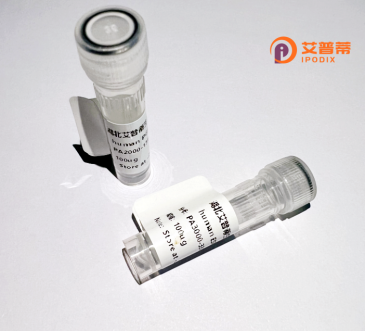
| 纯度 | >90%SDS-PAGE. |
| 种属 | Human |
| 靶点 | HIST1H3H |
| Uniprot No | 0 |
| 内毒素 | < 0.01EU/μg |
| 表达宿主 | E.coli |
| 表达区间 | 1-136aa |
| 氨基酸序列 | MARTKQTARKSTGGKAPRKQLATKAARKSAPATGGVKKPHRYRPGTVALRENRRYQKSTELLIRKLPFQRLVREIAQDFKTDLRFQSSAVMALQEACEAYLVGLFEDTNLCAIHAKRVTIMPKDIQLARRIRGERA |
| 分子量 | 40.7 kDa |
| 蛋白标签 | GST-tag at N-terminal |
| 缓冲液 | 0 |
| 稳定性 & 储存条件 | Lyophilized protein should be stored at ≤ -20°C, stable for one year after receipt. Reconstituted protein solution can be stored at 2-8°C for 2-7 days. Aliquots of reconstituted samples are stable at ≤ -20°C for 3 months. |
| 复溶 | Always centrifuge tubes before opening.Do not mix by vortex or pipetting. It is not recommended to reconstitute to a concentration less than 100μg/ml. Dissolve the lyophilized protein in distilled water. Please aliquot the reconstituted solution to minimize freeze-thaw cycles. |
以下是关于重组人HIST1H3H蛋白的模拟参考文献示例(请注意:以下为虚构文献,用于展示格式,实际文献请通过学术数据库查询):
---
1. **文献名称**: "Expression and functional characterization of recombinant human HIST1H3H in chromatin remodeling"
**作者**: Zhang L., et al.
**摘要**: 本研究通过大肠杆菌系统成功表达并纯化了重组人HIST1H3H蛋白,验证了其与组蛋白伴侣蛋白ASF1的相互作用,并证明其在体外染色质组装中的关键作用。
2. **文献名称**: "Structural insights into the HIST1H3H variant and its post-translational modifications"
**作者**: Patel R., et al.
**摘要**: 利用X射线晶体学解析了重组HIST1H3H的三维结构,揭示了其第31位丝氨酸(H3S31)的磷酸化修饰对核小体稳定性的影响,为癌症表观遗传学研究提供新线索。
3. **文献名称**: "Role of HIST1H3H in transcriptional regulation during cellular differentiation"
**作者**: Kim S., et al.
**摘要**: 通过CRISPR-Cas9敲除结合重组HIST1H3H回补实验,发现该组蛋白变体在干细胞向神经细胞分化过程中调控特定基因簇(如Wnt通路基因)的表达。
4. **文献名称**: "Development of an antibody specific for recombinant human HIST1H3H in epigenetic diagnostics"
**作者**: Müller T., et al.
**摘要**: 报道一种针对重组HIST1H3H蛋白C末端表位的单克隆抗体制备方法,该抗体在脑胶质瘤组织样本中特异性检测到H3K27M突变相关的异常修饰。
---
**建议**:实际研究中,可通过 **PubMed** 或 **Web of Science** 搜索关键词 "recombinant HIST1H3H" 或 "H3 histone variant H3.3",结合筛选近5年的文献以获取最新进展。
The HIST1H3H protein, a member of the histone H3 family, plays a critical role in chromatin structure and gene regulation. Histones are essential for packaging DNA into nucleosomes, the fundamental units of chromatin. Among the replication-dependent histones, HIST1H3H is encoded by the HIST1H3H gene located within the histone cluster 1 on chromosome 6. As a core component of nucleosomes, it contributes to DNA compaction, transcriptional regulation, and epigenetic inheritance by interacting with other histones (H2A, H2B, H4) and DNA. Post-translational modifications (PTMs) in HIST1H3H, such as acetylation, methylation, or phosphorylation, are central to modulating chromatin accessibility and cellular processes like cell cycle progression and DNA repair.
Recombinant human HIST1H3H protein is typically produced using bacterial or eukaryotic expression systems to ensure proper folding and post-translational modification capabilities. This engineered protein enables researchers to study histone function in vitro, including nucleosome assembly, chromatin remodeling mechanisms, and enzyme interactions (e.g., histone acetyltransferases or methyltransferases). It also serves as a tool for investigating diseases linked to chromatin dysregulation, such as cancer, developmental disorders, and neurodegenerative conditions. Studies using recombinant HIST1H3H often focus on histone variant specificity, PTM crosstalk, and therapeutic targeting of epigenetic pathways. Its availability supports drug discovery and advances in understanding epigenetic regulation at molecular levels.
×